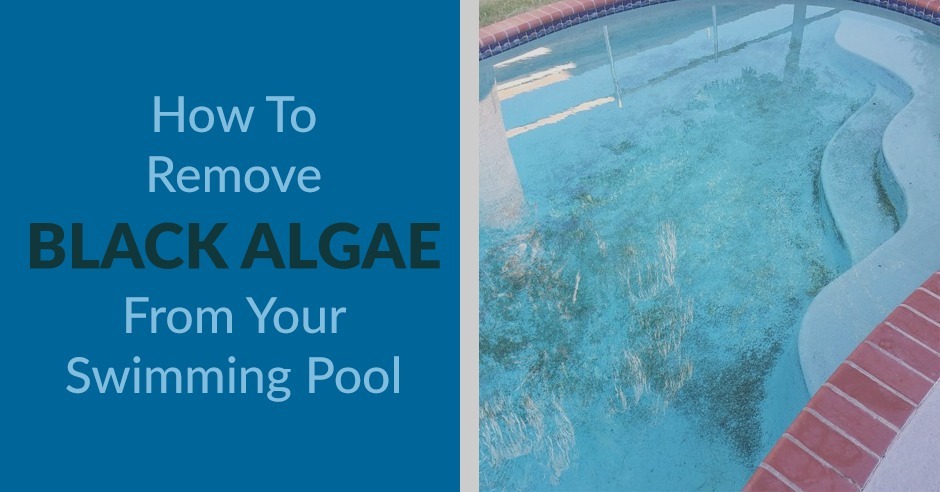If you need to remove black algae from your swimming pool, then knowing the most effective way to do that is worth your time. Of all the types of pool algae, black algae are one of the hardest to get rid of. The longer it goes untreated, the stronger it gets, and the harder it becomes to destroy. This is because, over time, black pool algae creates several protective layers that make it especially resistant to chlorine treatment.
Black pool algae most often form on the walls and steps of concrete and plaster pools. And it deeply embeds itself into the pores of those surfaces.
This is why removing black algae requires a very specific approach — especially if you want to permanently kill the black algae and prevent it from growing in your pool again.
If you want to destroy black algae and stop it from coming back, then follow the steps outlined in this guide. You’ll learn how to remove black algae, what causes it, and how to prevent it in the future.
How To Remove Black Algae From Your Swimming Pool
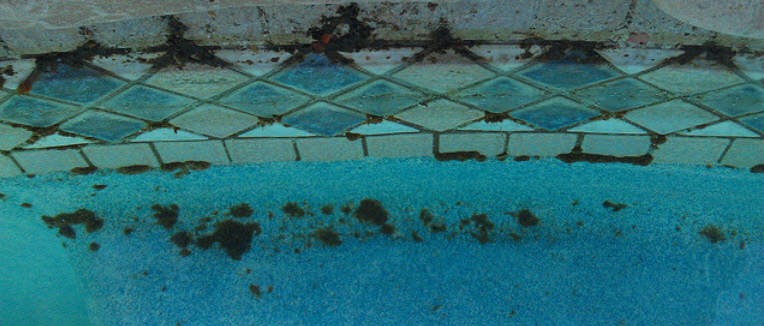


What is black algae?
Black algae is a strong, and chemically-resistant algae strain that forms on the surfaces of concrete and plaster pools. As mentioned earlier, this strain of algae is notorious for being hard to remove. Mostly because it forms a thick, protective shell over itself that helps it resist chlorine. Which is why removing black pool algae usually requires aggressive brushing and chemical treatment, but more on that later.
Odds are, if you see black spots or splotches growing in your pool, it’s the early warning signs of a black algae infestation.
When it comes to size, the black spots can be anywhere from a large mass over a foot wide, to the size of a quarter or pinhead.
But the earlier you notice these signs and act, the easier it’ll be to remove the black algae from your pool.
What does black algae look like?
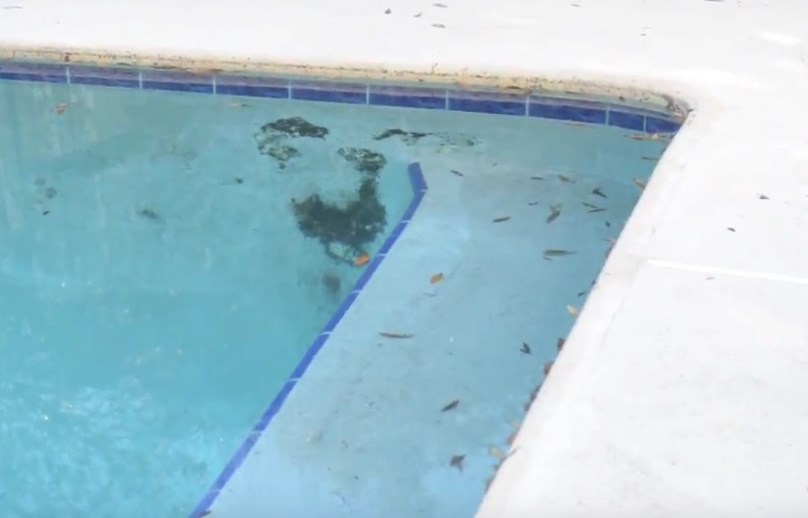


Black algae are pretty easy to notice, as it appears in the form of distinct, black spots or splotches on the walls of your pool. And although it technically has a black shade when in your pool, black algae is actually a very dark shade of green.
In terms of scientific classification, it’s known as a cyanobacterium, and is an alternate form of blue-green algae.
How to identify black pool algae
If you’re wondering how to identify black pool algae more accurately (using more than just your eyes), do the following:
- Scrape off a sample of the algae (the more the better)
- Spread the algae sample onto a paper towel or white piece of paper
- Observe the spread for a dark green smear (this is black algae)
What causes it?
A few common causes of black algae include:
- Black algae spores getting into your water
- Unbalanced, dirty water
- Poor water circulation (not running filter at least 8 hours)
- Clogged/dirty skimmer basket or pump basket
- Clogged/dirty filter
- Letting all of the above happen for a long time
In short, the conditions that black algae thrive in are mainly poor water filtration and bad chemical balance. That said, it’s also important to understand where black algae spores (the root cause) comes from.
Where does black algae come from?
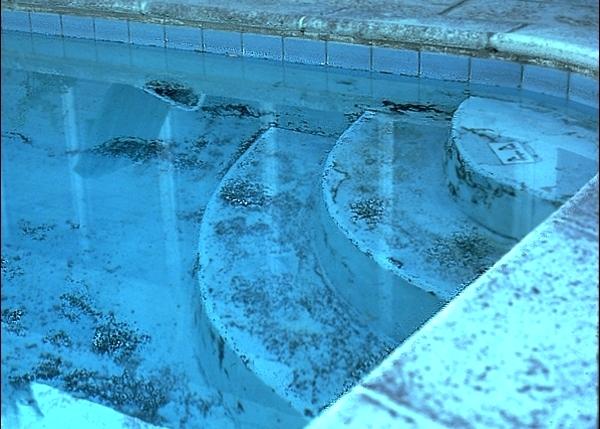


There are a few ways that black algae can get into your pool:
- Spores floating in the air and into the water (if you live close to a lake or ocean)
- Bathing suits or clothing exposed to ocean/lake water containing black algae
- Contact with swimmers who recently swam in an ocean or lake without showering
- Dogs carrying the spores in their fur or paws
- Residual algae trapped in an uncleaned pool filter
In most cases, black algae get into your pool when something or someone carrying the spores makes contact with your pool water.
How to get rid of and kill black algae in your swimming pool
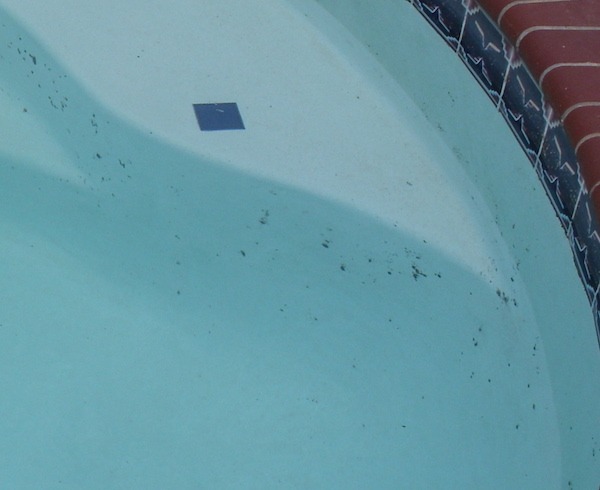


You’re just a short scroll away from learning how to remove black algae from your pool. But before you start on that, you’ll want to make sure you have all the right tools for the job. That way, you get the best results.
Here’s what you need to remove black algae from your pool:
- 2 gallons of bleach
- Pool water test kit
- Stainless steel pool brush (or an equally stiff plastic brush for vinyl and fiberglass pool)
- 4 shock treatments (4-10 pounds of shock total depending on the size of your pool)
- Note: 1 pound per 10,000 gallons
- 3 doses of algaecide
- Regular pool chemicals (pH adjusters, Alkalinity adjusters, and chlorine)
Here’s a step by step guide for removing black algae from your pool:
1.) Sanitize all pool equipment
Everything from bathing suits and pool floats, to your maintenance equipment and pool filter could be carrying black algae spores. So the best course of action is to sanitize pretty much everything.
Anything that has come into contact with your water and pool should be cleaned.
- Wash bathing suits and towels (warm water & lots of detergents)
- Sanitize pool floats, toys, and noodles with bleach
- Scrub pool equipment (skimmer net, brush, pole) with bleach, then drop it in the pool to be sanitized by chlorine
- Empty, scrub and sanitize pool skimmer basket and pool pump basket
2.) Deep clean your pool filter
Black algae spores can hide inside of your filter, which makes them harder to remove. So even if you do everything in this guide, but forget to clean out your filter, the black algae can easily come back. Which means all your hard work will go to waste.
To avoid that, remember to do the following:
- Release the pressure from your filter using the pressure valve
- Open up your filter
- Remove the filter media (sand, cartridge, grid)
- Scrub and sanitize the inside of your filter
- Replace dirty filter media with a new, clean media (sand, DE grids & powder, cartridge)
3.) Test pool water levels/chemical
Since unbalanced water encourages algae growth, it’s important to keep your pH and Alkalinity at the right levels.
- Use your pool water test kit to check the levels of each chemical
- Adjust pH so that it sits between 7.4 to 7.6
- Adjust Alkalinity so that it’s between 120 and 150 ppm
Once you’ve tested and balanced your water, move on to the next step.
Related: How To Balance Your Swimming Pool Water in 7 Easy Steps
4.) Brush pool for the first time and target all algae spots
In order to permanently remove black algae, you have to scrub it away. Aggressively.
But in order for your scrubbing to be effective, you’ll need a special brush for getting rid of algae.
If you have a concrete or plaster pool, use a stainless steel pool brush for scrubbing away black algae. Use a lot of pressure, and don’t be shy – black pool algae will grip to your walls until you forcefully scrub it off.
If you have a fiberglass or vinyl pool, use a hard-bristled nylon or PVC brush.
4b) Try scrubbing with tablets
For an added boost, you can also try scrubbing the black algae spots with half of a chlorine tablet.
Simply break a chlorine tablet in half, put on some gloves, and start scrubbing with the broken/abrasive side of the tablet against the algae. This helps to further loosen up the algae hiding in the pores of your wall, while also working in a little pre-treatment chlorine.
5.) Triple shock your pool
For this step, you’ll be triple shocking your water. But make sure to add the shock at night, when the sun is down — this is when it’s most effective.
To triple shock your pool: add 3 pounds of shock for every 10,000 gallons of water
Depending on the size of your pool, this may total out to anywhere from 3-9 pounds of shock for this first treatment. For example, a 20,000-gallon pool would require 6 pounds of shock to be properly “triple shocked”.
Don’t feel like calculating that? No problem, we did it for you:
- 10,000 gallon pool = 3 pounds of shock
- 15,000 gallon pool = 4.5 pounds of shock
- 20,000 gallon pool = 6 pounds of shock
- 25,000 gallon pool = 7.5 pounds of shock
- 30,000 gallon pool = 9 pounds of shock
NOTE: Once you add the shock (and algaecide), run your filter for at least 24 hours before moving on to the next step.
6.) Add algaecide
After shocking your pool, add 1-2 algaecide treatments. Then run your filter.
This will help prevent any lingering black algae spores from making a comeback.
7.) Quick clean filter again to remove remaining residue
Give your filter a quick cleaning this time to remove any algae that have been picked up.
For sand and DE filters, set your filter to backwash.
For cartridge filters, open your filter and rinse out the filter media thoroughly.
8.) Run filter again
After cleaning out your filter the 2nd time, turn it on again to start circulating your water.
9.) Brush again
With your filter running, it’s time to give your pool a 2nd scrub.
For the best results, scrub the entire wall and stairs (not just the spots) thoroughly. Every inch.
Then, after that, do a little bit of spot scrubbing for anything that still shows up.
10.) Add normal shock dose
To permanently kill black algae, about 2-3 days after brushing your pool, add a regular dose of shock.
A regular shock treatment is 1 pound of shock per 10,000 gallons. So if you had a 20,000-gallon pool, you’d only need 2 pounds of shock this time around.
10a.) If algae doesn’t go away
Repeat steps 4 through 10 until all traces of algae are gone.
11.) Maintain chemicals and clean
And last but not least, here’s how to prevent black algae from coming back in your pool:
- Keep your water balanced (maintain correct, pH, Alkalinity, and sanitizer levels)
- Run your pump at least 8 hours a day (longer the better)
- Regularly skim, brush, and vacuum your pool each week (use a pool care schedule to make this easy and save time)
- Routinely sanitize pool equipment, accessories, and toys
- Shock your pool at least once a week (regular dose, NOT triple)
Related: How To Keep Your Pool Clean Like a PRO
Closing thoughts
If you followed all the steps in this post, then you’ve successfully removed black algae from your swimming pool. And being that it’s the hardest kind of pool algae to get rid of, you deserve all the bragging rights for getting the job done yourself.
But don’t let all that hard work and scrubbing go in vain. Remember that the best way to prevent algae, is to keep your pool clean and your water balanced.
If you liked this post, you might also enjoy:
Fix a Green Pool in 5 Easy Steps
7 Things To Do To Your Pool After It Rains
21 Pool Maintenance Mistakes That Are Wasting Your Time & Money

